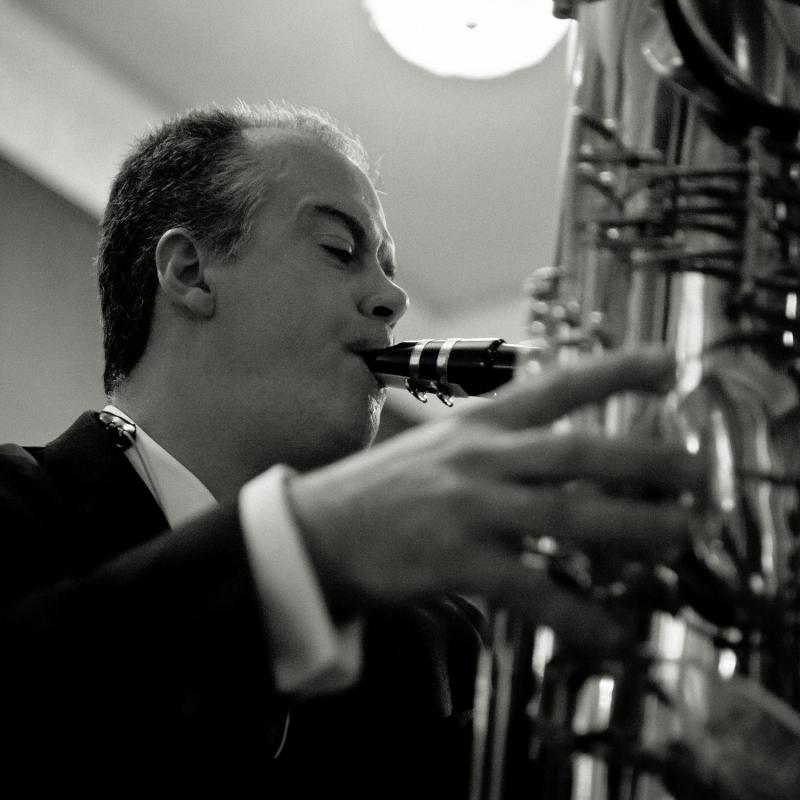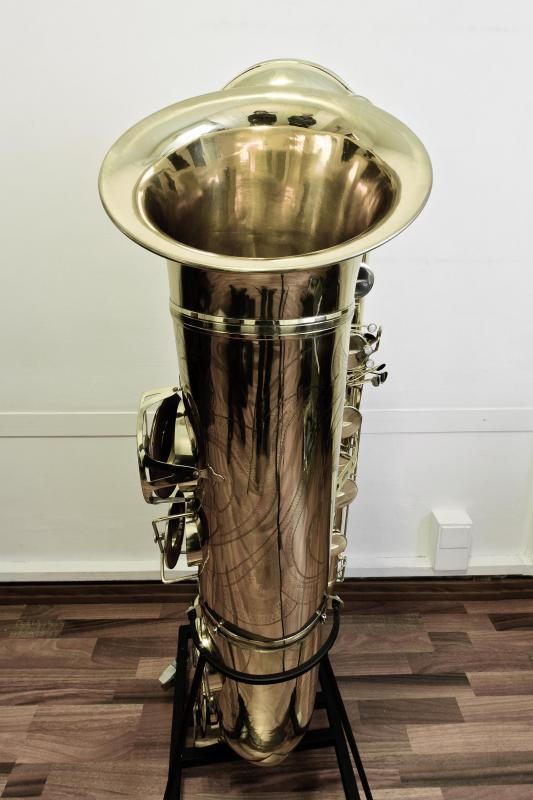 Forgot Username? Forgot Password?
Forgot Username? Forgot Password?
J’ELLE STAINER Double Bb SUB-CONTRABASS SAXOPHONE
J’ELLE STAINER SUB-CONTRABASS SAXOPHONE
The sub-contrabass saxophone is a model of saxophone that Adolphe Sax designed and planned but never realized. Adolphe Sax was a uniqu
was a uniqu e personage, with an early and highly developed musical intelligence that led him from an early age, to experiment and make musical instruments of excellent workmanship. An eclectic person in possession of great skills, he was able to develop and create immensely interesting projects, such as an exceptionally cumbersome organ powered by the engine of a locomotive in an a oval concert hall; a very unusual device able to tune simultaneously and perfectly all the strings of the piano and the Goudronniere; a "hygienic exhaler" that was used to purify the air of hospitals and sanatoriums. His inventions were so extraordinary that they caught the eye or such diverse luminaries as Hector Berlioz and Louis Pasteur. Sax called this imaginary saxophone bourdon saxophone. It would have been a transposing instrument in Bflat, one octave below the bass saxophone and two octaves below the tenor saxophone.
e personage, with an early and highly developed musical intelligence that led him from an early age, to experiment and make musical instruments of excellent workmanship. An eclectic person in possession of great skills, he was able to develop and create immensely interesting projects, such as an exceptionally cumbersome organ powered by the engine of a locomotive in an a oval concert hall; a very unusual device able to tune simultaneously and perfectly all the strings of the piano and the Goudronniere; a "hygienic exhaler" that was used to purify the air of hospitals and sanatoriums. His inventions were so extraordinary that they caught the eye or such diverse luminaries as Hector Berlioz and Louis Pasteur. Sax called this imaginary saxophone bourdon saxophone. It would have been a transposing instrument in Bflat, one octave below the bass saxophone and two octaves below the tenor saxophone.
The sub-contrabass J'Elle Stainer is exactly as Sax had envisioned. It’s a prototype, a unique piece entirely made by hand (pads included) whose design and construction took three years of work! The body tube has an overall length of almost 6 meters and obviously it has a very dark and almost cavernous sound. The lowest note, low A (real note) is close to the least threshold of audibility: 27.5Hz! In order to realise the size let’s make a comparison with a Selmer SA 80 Series III alto saxophone:
|
comparisons |
Selmer S.A.80III alto sax |
J’Elle Stainer sub-contrabass sax |
|
Inside air volume |
about 2 liters |
about 40 liters |
|
Bell diameter |
11.5cm |
38cm |
|
Bell circumference |
38cm |
120cm |
|
Hole diameter low B |
4cm |
2 holes: 14cm and 11cm |
|
Range |
Bb-F# |
B- F# |
|
(in Hertz) |
from 207.6Hz to 803.6Hz |
from 27.5Hz to 164.8Hz |
|
Engraving |
by pantograph |
by hand |
|
Columns |
soldered on the plate |
directly soldered on the body |
|
Plate thickness |
0.6mm |
0.71mm |
|
Pads |
leather (industrial) |
leather (handmade) |
|
Resonators |
metal |
metal |
|
Left/Right thumb rests |
plastic- plastic |
plastic - metal |
|
Holes |
extruded |
soldered |
|
Body total length |
about 1.16m |
about 5.950m |
|
Weight |
2.1Kg |
24.3Kg |
APPEARANCE

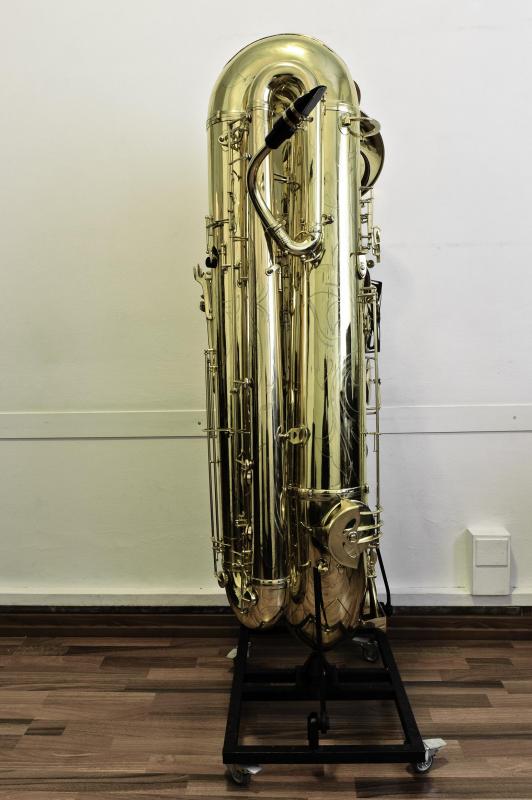 Despite the various bends and the compact shape, the instrument is aesthetically balanced and elegant. On the lower curve a ferrule is fixed to the bow that is required to play the instrument in the seated position by leaning it on a specific stand. The current model is shown with a custom made case and a special mouthpiece with artistically worked ligature. A note on the polypropylene mouthpiece: J’Elle Stainer provides customers a personalized mouthpiece for their instruments. The chamber and the facing are unique to this piece and calculated to enhance the instrument’s timbre and response. The mouthpiece is similar in design to that of the contrabass sax mouthpiece with a slightly closed tip opening that gives a full, warm, dark tone and makes it easy to attack in both low and high registers. As such, this instrument is suitable for any kind of performance from classical, to chamber or jazz music.
Despite the various bends and the compact shape, the instrument is aesthetically balanced and elegant. On the lower curve a ferrule is fixed to the bow that is required to play the instrument in the seated position by leaning it on a specific stand. The current model is shown with a custom made case and a special mouthpiece with artistically worked ligature. A note on the polypropylene mouthpiece: J’Elle Stainer provides customers a personalized mouthpiece for their instruments. The chamber and the facing are unique to this piece and calculated to enhance the instrument’s timbre and response. The mouthpiece is similar in design to that of the contrabass sax mouthpiece with a slightly closed tip opening that gives a full, warm, dark tone and makes it easy to attack in both low and high registers. As such, this instrument is suitable for any kind of performance from classical, to chamber or jazz music.
The body and the keys are finished gold in colour with floral engravings over the whole bell.
ERGONOMICS
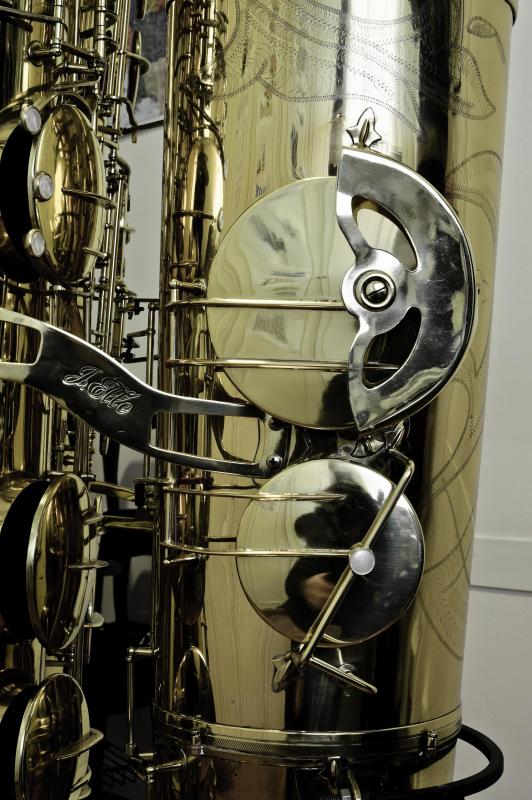
 Despite the enormous size of the instrument and the extremely long keys, rods and hinge tubes, the ergonomics are remarkably comfortable. However, the exceptional dimensions of the instrument do require some adjustments and practice in order to play well. It has adopted a "Selmer-Style" key system with essentially the same construction features of a modern Selmer ensuring that nothing is particularly unmanageable even in the most complex of passages.
Despite the enormous size of the instrument and the extremely long keys, rods and hinge tubes, the ergonomics are remarkably comfortable. However, the exceptional dimensions of the instrument do require some adjustments and practice in order to play well. It has adopted a "Selmer-Style" key system with essentially the same construction features of a modern Selmer ensuring that nothing is particularly unmanageable even in the most complex of passages.
Certain difficulties that exist include:
- The key positioning necessitates that the left hand must take a slightly curved and uncomfortable position which compromises technical agility to some extent.
- The key positioning and distance travelled by the table keys and C/Eb keys makes it difficult if not nearly impossible to switch between certain notes.
- Because of how the body tube bends, the palm key tone holes are positioned below their respective keys and therefore reversed in comparison to a traditional saxophone. The player has a very different feeling playing these keys, and therefore it is necessary to get used to this position. Additionally, the keys are separated a far distance from one another hindering fluidity.
MECHANICS
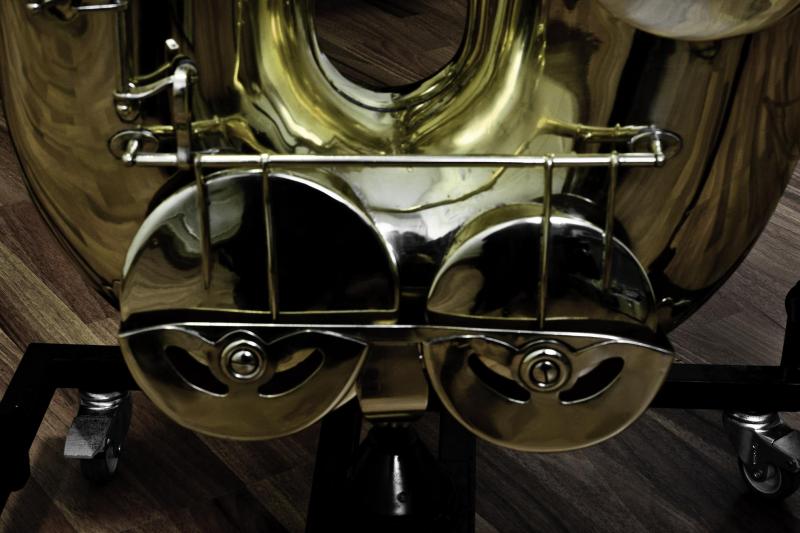
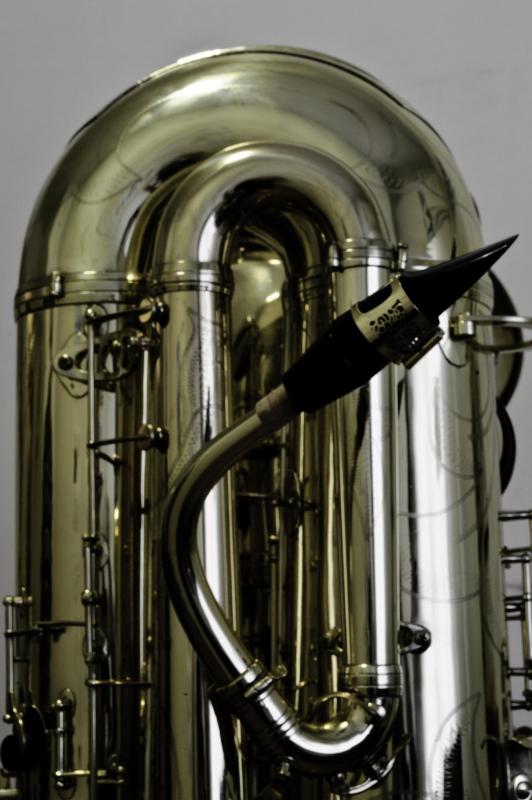 Due to this saxophones particular shape, literally rolled up on itself, the mechanics are extremely complex and intricate. The manufacturer was faced with the difficult struggle of maintaining manageable ergonomics while not abandoning any keys (which would have simplified the work but made the instrument incomplete). It’s a very impressive feat when one considers the enormity of the work required to forge the hundreds of pieces that make up the complex mechanics of the sub-contrabass.
Due to this saxophones particular shape, literally rolled up on itself, the mechanics are extremely complex and intricate. The manufacturer was faced with the difficult struggle of maintaining manageable ergonomics while not abandoning any keys (which would have simplified the work but made the instrument incomplete). It’s a very impressive feat when one considers the enormity of the work required to forge the hundreds of pieces that make up the complex mechanics of the sub-contrabass.
The instrument has two register keys that operate 6 holes. The first one is an automatic register key that operates with 5 holes (the first three for the emission of notes from D to G and then the next two for the notes from A on); while the second register key is for the altissimo registry.
The noise of the mechanics, generally quite low, can at times be somewhat loud. It is in fact a very bulky and complex instrument where it is necessary to press some keys with considerable force (eg: to obtain the low C and the low B the manufacturer had to make two holes for every note, each one corresponding to two very large cups).
THE SOUND

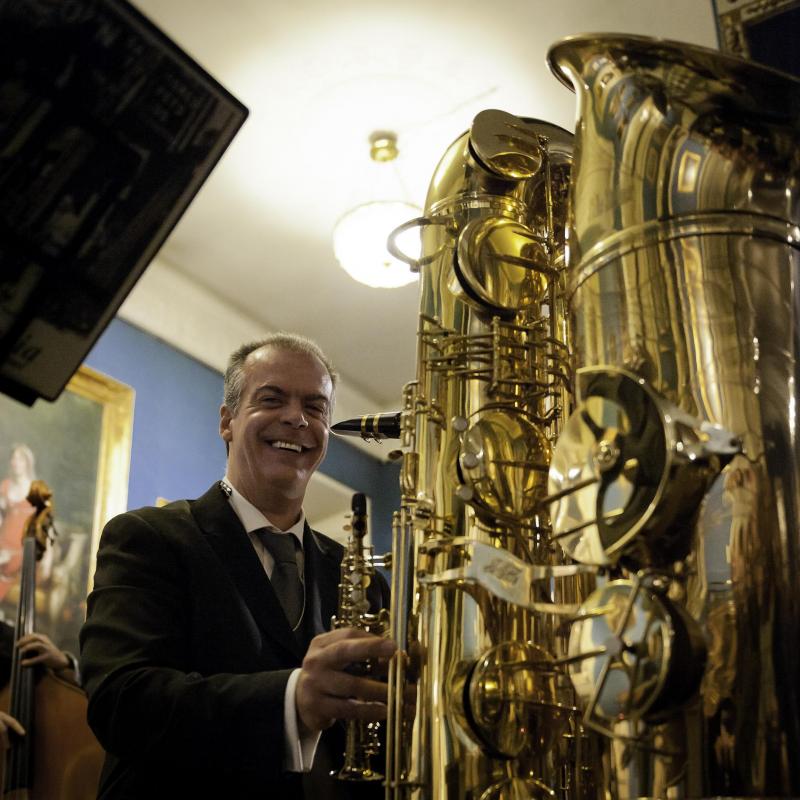 The sound of the sub-contrabass is incredibly full and uniform throughout all registers even as the air expenditure required in the low register is immense. The sound production technique is unique as it requires large quantities of air to be blown but with a very slight pushing pressure. As such, the musician must train in order to learn to allocate and ration his breath appropriately and apply the correct pressure so that the fundamental note is generated and not a harmonic. As with all extreme low register saxophones, difficulties arise in the register change from middle C to D and in tone production of middle D, E and F. Production of high A can also be challenging. However, this is manageable and becomes controllable after a little practice with embrasure and mouthpiece positioning.
The sound of the sub-contrabass is incredibly full and uniform throughout all registers even as the air expenditure required in the low register is immense. The sound production technique is unique as it requires large quantities of air to be blown but with a very slight pushing pressure. As such, the musician must train in order to learn to allocate and ration his breath appropriately and apply the correct pressure so that the fundamental note is generated and not a harmonic. As with all extreme low register saxophones, difficulties arise in the register change from middle C to D and in tone production of middle D, E and F. Production of high A can also be challenging. However, this is manageable and becomes controllable after a little practice with embrasure and mouthpiece positioning.
This unique instrument allows the player to attack even the lowest notes with relative ease and softness unlike other bass and contrabass instruments which often oblige the player to violently attack the note. The control and dynamics is quite impressive in all registers and intonation, in general, is excellent as well.
THE COMPANY
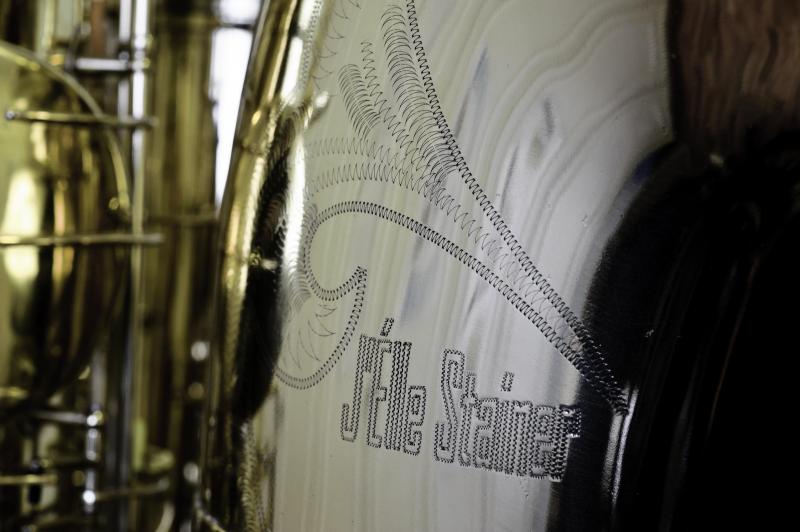
 J'Elle Stainer is the name of a small artisan factory located in Mairiporã in the metropolitan region of San Paolo in Brazil, founded in 2011 by an incredible craftsman named João Luiz da Rocha. The instrument was created to satisfy the growing demand in the Brazilian market for the production of low saxophones and double basses to replace the tuba and the tuba bass, giving orchestras a more mellow sound typical of reed instruments during the Christian Congregation rites. The Christian Congregation in Brazil is one of the most dynamic evangelical movements in the country, founded by the Italian missionary Louis Francescon (1866-1964) in 1910. From 2001-2011, Joao Luiz da Rocha has produced about 100 low saxophones and about 10 double basses. In 2006, in collaboration with the entrepreneur saxophonist Gilberto Lopes, he began to develop various extreme instruments of excellent quality. This collaboration has yielded countless prototypes, special slide saxophones or keyless instruments, in addition to the creation of this unique sub-contrabass saxophone: an instrument that fully respects the bore and the interior chamber proportions indicated and idealized by the inventor Adolphe Sax 150 years ago. This collaboration has brought J'Elle Stainer beyond the Brazilian borders and today their extreme saxophones are used by professional musicians and orchestras in the U.S., Canada, Australia, Holland, Germany, Italy, United Kingdom, Austria and other countries.
J'Elle Stainer is the name of a small artisan factory located in Mairiporã in the metropolitan region of San Paolo in Brazil, founded in 2011 by an incredible craftsman named João Luiz da Rocha. The instrument was created to satisfy the growing demand in the Brazilian market for the production of low saxophones and double basses to replace the tuba and the tuba bass, giving orchestras a more mellow sound typical of reed instruments during the Christian Congregation rites. The Christian Congregation in Brazil is one of the most dynamic evangelical movements in the country, founded by the Italian missionary Louis Francescon (1866-1964) in 1910. From 2001-2011, Joao Luiz da Rocha has produced about 100 low saxophones and about 10 double basses. In 2006, in collaboration with the entrepreneur saxophonist Gilberto Lopes, he began to develop various extreme instruments of excellent quality. This collaboration has yielded countless prototypes, special slide saxophones or keyless instruments, in addition to the creation of this unique sub-contrabass saxophone: an instrument that fully respects the bore and the interior chamber proportions indicated and idealized by the inventor Adolphe Sax 150 years ago. This collaboration has brought J'Elle Stainer beyond the Brazilian borders and today their extreme saxophones are used by professional musicians and orchestras in the U.S., Canada, Australia, Holland, Germany, Italy, United Kingdom, Austria and other countries.





